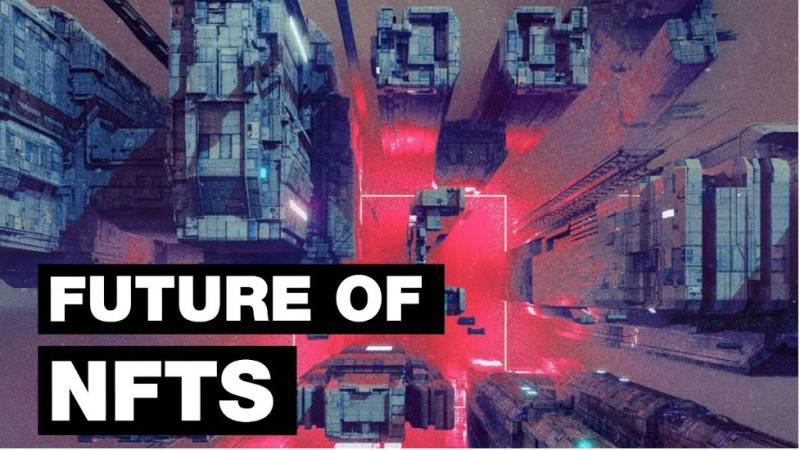The Future of NFTs: Predictions and Trends for the Next Decade

The world of non-fungible tokens (NFTs) has been rapidly expanding since their inception in 2017. NFTs have revolutionized the way we think about digital assets, offering a way to verify ownership and authenticity of unique digital items such as artwork, music, and even tweets. As the hype surrounding NFTs continues to grow, many businesses are looking to get involved in this new and exciting industry.
In this blog post, we will discuss the future of NFTs and provide predictions and trends for the next decade. As a leading NFT development company, we have a deep understanding of the NFT market and the potential it holds for businesses. We will discuss various topics related to the future of NFTs, such as the impact of blockchain technology on NFTs, the potential for NFTs to be used in industries beyond art and music, and the role of NFT marketplaces in the ecosystem.
Additionally, we will explore the potential for new and innovative use cases for NFTs, such as in gaming and virtual reality. For businesses looking to enter the NFT space, this blog post will provide valuable insights and predictions for the future of the industry.
Whether you're an artist looking to sell your digital creations as NFTs or a business exploring new ways to monetize your digital assets, the future of NFTs is full of potential and you should be excited to explore it.
Future Potential of NFTs
Many experts predict that the NFT market will continue to grow in the coming years. For example, a report by NonFungible.com estimated that the total sales volume of NFTs could reach $93 billion by 2024. Some factors that could contribute to this growth include:
- Increasing mainstream adoption: As more artists, musicians, and celebrities enter the NFT space, it is likely that more mainstream consumers will become interested in purchasing NFTs.
- New use cases: NFTs are not limited to art and collectibles; they could also be used in industries such as gaming, sports, and real estate. As new use cases are developed, it could drive further growth in the NFT market.
- Advancements in blockchain technology: As blockchain technology continues to improve, it could make NFTs more accessible, secure, and scalable. This could attract more businesses and investors to the NFT space.
- Growing interest from institutional investors: Some institutional investors, such as hedge funds and venture capital firms, are starting to invest in NFTs. This could provide additional capital and legitimacy to the NFT market.
Overall, while the future of the NFT market is uncertain, there are many reasons to believe that it will continue to grow and evolve in the coming years.
Predictions of NFT’s Future
The rise of non-fungible tokens (NFTs) has been one of the most significant developments in the digital world in recent years. NFTs offer a way to authenticate and verify ownership of unique digital assets such as art, music, and even tweets, opening new possibilities for creators and collectors alike.
As the NFT market continues to grow, it's worth taking a closer look at what the future holds for this technology. From mainstream adoption to new use cases, various trends and developments could shape the NFT market in the years to come. Advancements in blockchain technology, for example, could impact the future of NFTs, as well as potential challenges and opportunities facing this emerging industry.
Whether you're a creator looking to monetize your digital assets, an investor interested in collecting NFTs, or a business exploring new ways to leverage this technology, understanding the future of NFTs is essential.
Insights into the latest trends and developments can provide a clearer picture of what's to come in the NFT space and help you make informed decisions about how to best utilize this exciting technology.
Key predictions and trends in NFTs:
- Continued Growth
- Integration with Traditional Industries
- Increased Focus on Sustainability
- NFTs as a Tool for Identity and Verification
- Integration with DeFi
1. Continued Growth
One of the most prominent predictions for the future of NFTs is continued growth. The NFT market has already seen tremendous growth over the past few years, with total sales volume reaching billions of dollars in 2021. This growth is expected to continue as more people become aware of NFTs and their potential applications.
One reason for the predicted growth is increasing mainstream adoption. As more celebrities, musicians, and artists enter the NFT space, it's likely that more mainstream consumers will become interested in purchasing NFTs. This could include businesses that want to monetize their digital assets, as well as individuals who want to collect and invest in NFTs.
Another factor contributing to continued growth is new use cases. While NFTs are most commonly associated with art and collectibles, they have the potential to be used in a wide range of industries. For example, NFTs could be used in the gaming industry to represent in-game assets or virtual real estate. They could also be used in the sports industry to represent memorabilia or even tickets to events.
In addition, advancements in blockchain technology could also contribute to the growth of NFTs. As blockchain technology continues to improve, it could make NFTs more accessible, secure, and scalable. This could attract more businesses and investors to the NFT space, leading to even more growth.
Overall, the future looks bright for NFTs, with continued growth expected in the years to come. As the technology evolves and new use cases are developed, we could see NFTs become even more widely adopted and utilized in a range of industries.
2. Integration with Traditional Industries
Another prediction for the future of NFTs is their integration with traditional industries. As NFTs gain more mainstream adoption, it's likely that they will be integrated with existing industries, such as art, music, and real estate.
For example, in the art world, NFTs have already disrupted the traditional art market by offering a new way to buy and sell digital art. In the music industry, NFTs could be used to represent ownership of music rights or even concert tickets. And in the real estate industry, NFTs could be used to represent ownership of virtual real estate or even physical properties.
Integration with traditional industries could provide many benefits for NFTs, such as increased legitimacy and exposure. It could also offer new opportunities for businesses and investors to leverage NFTs in a variety of industries.
However, integrating NFTs with traditional industries could also present some challenges. For example, there could be legal and regulatory hurdles to overcome, as well as concerns around scalability and security. Additionally, some industries may be resistant to change, which could slow down the adoption of NFTs.
Despite these challenges, the potential benefits of integrating NFTs with traditional industries make it a promising area for future development. As more industries explore the potential of NFTs and overcome these challenges, we could see widespread adoption of NFTs in a range of sectors, leading to even more growth and innovation in the space.
3. Increased Focus on Sustainability
Another prediction for the future of NFTs is an increased focus on sustainability. As the NFT market continues to grow, concerns have been raised about the environmental impact of blockchain technology, which is used to create and verify NFT transactions.
The process of creating and verifying NFTs requires a significant amount of computational power, which in turn requires a significant amount of energy. This has led to concerns about the carbon footprint of NFTs and their impact on the environment.
To address these concerns, we may see an increased focus on sustainability in the NFT space. This could include the development of more energy-efficient blockchain technology, as well as the use of renewable energy sources to power NFT transactions. It could also involve the implementation of sustainable practices in NFT development and usage, such as the use of eco-friendly materials in the creation of digital art.
In addition to addressing environmental concerns, an increased focus on sustainability could also offer new opportunities for businesses and investors in the NFT space. By incorporating sustainability into their NFT development and usage, businesses and investors could differentiate themselves from their competitors and appeal to consumers who are increasingly concerned about environmental issues.
Overall, sustainability is likely to become an increasingly important consideration in the NFT space. As businesses, investors, and consumers become more aware of the environmental impact of blockchain technology, we may see a greater emphasis on sustainability in NFT development and usage. This could lead to the development of new, innovative solutions that help to address these concerns while still allowing for the continued growth and adoption of NFTs.
4. NFTs as a Tool for Identity and Verification
Another prediction for the future of NFTs is their use as a tool for identity and verification. One of the unique features of NFTs is their ability to provide proof of ownership and authenticity, which could be leveraged in a variety of applications.
For example, NFTs could be used to represent digital identities, providing a secure and verifiable way for individuals to prove their identity online. This could be particularly useful in industries such as finance and healthcare, where secure identity verification is critical.
NFTs could also be used to represent certifications or qualifications, such as degrees or professional licenses. This could provide a more secure and efficient way to verify credentials, reducing the risk of fraud and increasing trust in the system.
In addition, NFTs could be used to represent physical assets, such as luxury goods or high-value collectibles. By creating an NFT that represents ownership of a physical asset, it could be easier to verify the authenticity of the asset and track its ownership history.
Overall, the ability of NFTs to provide secure and verifiable proof of ownership and authenticity makes them a promising tool for identity and verification. As more industries explore the potential of NFTs in this area, we could see the development of new, innovative applications that leverage this technology to improve security and trust in a range of systems.
5. Integration with DeFi
Another prediction for the future of NFTs is their integration with decentralized finance (DeFi). DeFi refers to a system of financial applications that operate on a decentralized blockchain network, allowing for peer-to-peer transactions without the need for intermediaries like banks or financial institutions.
As NFTs gain more mainstream adoption, they could be integrated with DeFi applications to create new opportunities for investment and financial services. For example, NFTs could be used as collateral for loans in DeFi lending protocols, allowing investors to borrow against the value of their NFTs.
Additionally, NFTs could be used as a tool for asset management in DeFi applications. By creating an NFT that represents ownership of a specific asset, it could be easier to track ownership and value changes, and to trade the asset on a decentralized exchange.
To enable these types of applications, blockchain development services and DeFi development companies are likely to play a critical role in the integration of NFTs with DeFi. These companies will need to work together to develop new protocols and platforms that enable the seamless integration of NFTs with DeFi applications.
Overall, the integration of NFTs with DeFi has the potential to create new opportunities for investment and financial services, while also offering a more efficient and transparent way to manage assets. As blockchain development services and DeFi development companies continue to work together to explore the potential of this integration, we could see the development of new, innovative applications that leverage the unique features of NFTs and DeFi to transform the financial landscape.
Innovative Applications of NFT
The world of non-fungible tokens (NFTs) is constantly evolving, with new trends and innovations emerging all the time. As the market for NFTs continues to grow, creators and investors alike are exploring new ways to leverage this technology and unlock its full potential.
In this context, it is important to stay up-to-date with the latest trends in NFTs to ensure that you are making informed decisions as a business owner or investor. Whether you are a blockchain development company, NFT development services provider, or simply an enthusiast of this technology, understanding the latest trends can help you stay ahead of the curve and take advantage of new opportunities.
Some of the latest applications and trends in NFTs include fractionalized NFTs, gamification, celebrity endorsements, and more. Each of these trends offers unique opportunities for creators and investors alike, and is helping to drive the continued growth and adoption of NFTs.
By staying informed about these trends and keeping a close eye on developments in the world of NFTs, you can position yourself for success in this rapidly-evolving market.
Key applications and trends in NFTs:
- Gaming
- Music
- Sports
- Virtual Real Estate
- Social Media
- Sustainability
1. Gaming
A trending application of NFTs lies in their increasing use in the gaming industry. NFTs offer a way to create unique and rare in-game items, such as weapons, skins, and characters, that can be bought, sold, and traded on blockchain-based marketplaces.
This provides a new revenue stream for game developers and allows players to own and control their in-game assets in a way that was not possible before. In addition, NFTs can be used to provide provable scarcity and authenticity to in-game items, adding to their value and appeal.
Some game developers are even using NFTs to create entirely new gaming experiences, such as blockchain-based games that allow players to compete for ownership of virtual land or participate in decentralized economies within the game world.
Overall, the integration of NFTs with the gaming industry has the potential to revolutionize the way we think about in-game assets and provide new opportunities for revenue generation and player engagement.
As more game developers and blockchain development companies explore the potential of NFTs in this area, we can expect to see continued growth and innovation in the intersection of gaming and blockchain technology.
2. Music
Among the various innovative ways NFTs are helping the music industry include:
- Direct artist-fan interaction: NFTs provide a way for artists to directly interact with their fans and offer unique, exclusive experiences. For example, an artist can create an NFT that gives the owner access to a private concert, backstage passes, or other exclusive content.
- Revenue generation: NFTs can be sold for a high value, providing a new revenue stream for artists and record labels. NFTs can represent ownership of a unique music asset, such as an unreleased song, a piece of artwork, or even a signed guitar.
- Royalties: NFTs can be programmed to automatically pay royalties to the artist or rights holders each time the NFT is resold, providing a way for artists to earn ongoing revenue from their work.
- Unique merchandise: NFTs can be used to represent unique merchandise, such as one-of-a-kind vinyl records or concert tickets. This provides a new way for artists to create exclusive merchandise and connect with their most dedicated fans.
- Authenticity: NFTs can provide proof of ownership and authenticity, helping to combat piracy and protect the rights of artists and rights holders.
Overall, NFTs provide a new way for artists and record labels to monetize their work and engage with fans in unique and innovative ways.
3. Sports
NFTs have already begun to make waves in the sports industry, and their impact is expected to grow in the coming years. NFTs provide a unique opportunity for athletes, teams, and sports organizations to monetize their brand and assets, and to connect with fans in new and innovative ways.
Some potential ways NFTs could shape the future of the sports industry include:
- Collectibles: NFTs can be used to create unique digital collectibles, such as playing cards or game highlights, that can be bought and sold on digital marketplaces. These collectibles can be authenticated using blockchain technology, making them more valuable to collectors.
- Fan engagement: Sports organizations can use NFTs to offer exclusive experiences to fans, such as meet and greets with players or VIP access to events. NFTs can also be used to incentivize fan engagement, such as rewarding fans for attending games or participating in social media campaigns.
- Sponsorship and advertising: NFTs can be used to create unique advertising opportunities for brands, such as sponsoring an NFT collectible or offering exclusive NFTs to customers who purchase a product.
- Player contracts: NFTs could potentially be used to create new forms of player contracts, where a portion of a player's earnings are tied to the performance of an NFT that represents their brand.
- Ticketing: NFTs can be used to create digital tickets that are authenticated using blockchain technology, making them more secure and harder to counterfeit.
Overall, the potential uses of NFTs in the sports industry are vast, and we can expect to see many innovative applications in the coming years as the technology continues to evolve.
4. Virtual Real Estate
The concept of virtual real estate is still relatively new, but NFTs are already playing a significant role in shaping its future. NFTs provide a way to authenticate and sell virtual real estates, such as land in a virtual world or a digital building.
Some potential ways NFTs could shape the future of the virtual real estate industry include:
- Digital ownership: NFTs can be used to prove ownership of the virtual real estate, similar to how traditional property deeds are used. This creates a sense of scarcity and exclusivity around virtual real estate, making it more valuable to collectors.
- Investment opportunities: NFTs can be used to create investment opportunities in virtual real estate, allowing investors to purchase and trade virtual land or buildings. This can create a new asset class for investors and potentially lead to new forms of financing for virtual real estate development.
- Gaming: NFTs can be used to create unique in-game items or spaces, such as a digital arena or a custom avatar. This creates new opportunities for game developers to monetize their products and for players to invest in their favorite games.
- Advertising and Sponsorship: Brands can use NFTs to advertise and sponsor virtual real estate properties or in-game items. This creates new revenue streams for virtual real estate owners and game developers.
- Virtual Events: NFTs can be used to create exclusive access to virtual events, such as concerts or art shows, held in virtual spaces. This creates new opportunities for artists and event organizers to connect with audiences in new and innovative ways.
Overall, the potential uses of NFTs in the virtual real estate industry are vast, and we can expect to see many innovative applications in the coming years as the technology continues to evolve.
5. Social media
NFTs are already beginning to make an impact in the social media industry, and their role is expected to grow in the coming years. NFTs provide a unique opportunity for content creators and social media platforms to monetize their content and engage with fans in new and innovative ways.
Some potential ways NFTs could shape the future of the social media industry include:
- Digital Art and Collectibles: NFTs can be used to authenticate and sell digital art and collectibles, such as memes, GIFs, and short videos. This creates a new revenue stream for content creators and social media platforms.
- Fan Engagement: Social media platforms can use NFTs to incentivize fan engagement, such as rewarding fans for liking and sharing content. This creates a new way for content creators to monetize their content and engage with their fans.
- Authenticity and Verification: NFTs can be used to verify the authenticity of social media content, such as tweets or posts, and to prevent the spread of fake news or misinformation.
- Sponsorship and Advertising: NFTs can be used to create unique advertising opportunities for brands, such as sponsoring an NFT collectible or offering exclusive NFTs to customers who purchase a product.
- Virtual Experiences: NFTs can be used to create virtual experiences, such as exclusive access to online events or VIP meet-and-greets with social media influencers. This creates new opportunities for content creators to connect with their fans in new and innovative ways.
Overall, the potential uses of NFTs in the social media industry are vast, and we can expect to see many innovative applications in the coming years as the technology continues to evolve.
6. Sustainability
Sustainability is a critical issue facing the world today, and it is important to consider the impact of new technologies like NFTs on the environment and society.
One of the main concerns with NFTs is the environmental impact of the blockchain technology used to create and authenticate them. The process of mining cryptocurrencies like Bitcoin and Ethereum, which are used to create and trade NFTs, requires a significant amount of energy and can contribute to carbon emissions. However, there are efforts to create eco-friendlier and more sustainable blockchain technologies that could be used in the future.
Another sustainability concern with NFTs is the potential for them to contribute to the exploitation of artists and creators. While NFTs can provide a new revenue stream for content creators, there are concerns about the fairness of the revenue distribution and the potential for NFTs to create new forms of wealth inequality.
To address these concerns, it is important for the NFT industry to prioritize sustainability and social responsibility. This could involve measures such as:
- Encouraging the development of more sustainable and eco-friendlier blockchain technologies.
- Ensuring that NFT platforms provide fair compensation to content creators and artists.
- Promoting transparency and accountability in the NFT market.
- Encouraging the use of NFTs for social good, such as supporting charitable causes or promoting environmental sustainability.
Overall, the sustainability of NFTs will depend on the actions taken by the industry and its stakeholders to address the environmental and social concerns associated with this emerging technology.
In Conclusion
The future of NFTs is a rapidly evolving landscape that presents numerous opportunities and challenges. As blockchain technology continues to mature and new use cases emerge, we can expect NFTs to become an increasingly important part of the digital economy.
One of the most exciting aspects of NFTs is their potential to democratize access to the value of digital assets, enabling creators and collectors to monetize their work and build new communities of fans and supporters. At the same time, concerns around sustainability, fairness, and regulatory compliance will need to be addressed in order to ensure the long-term viability and success of the NFT market.
Looking ahead, we can expect to see continued innovation and experimentation with NFTs, as well as increasing interest from investors, artists, and collectors. As the market matures, we may also see the emergence of new standards and best practices for NFT creation and trading, as well as new opportunities for collaboration and co-creation.
Overall, the future of NFTs is exciting and full of potential. It will be fascinating to watch how this technology evolves and transforms the way we think about ownership, value, and creativity in the digital age.





















